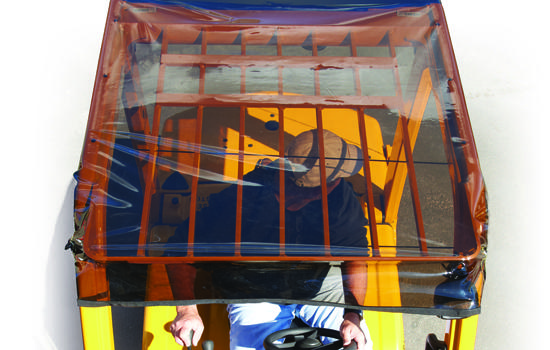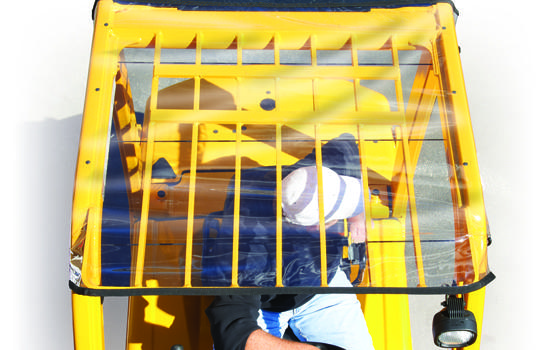When you think of forklift safety,you probably imagine flashing lights and backup alarms. But have you ever thought about the person driving the forklift? What’s protecting them from the blazing sun, sudden rain, or falling objects?
That’s where a forklift roof cover comes in. It’s more than just a roof. It's protection, peace of mind, and sometimes, a legal requirement. In this blog, we’ll walk you through why every forklift should have a roof cover, what options are available, and how it can protect your people and machines.
What Is a Forklift Roof Cover?
A forklift roof cover is a shield that sits on top of the forklift’s overhead guard. It can be made from steel, plastic, polycarbonate, or heavy-duty fabric. Think of it as a mini-roof for your driver. It protects them from the weather, falling debris, and more. Plus, it’s not just about comfort but also about compliance, safety, and performance.
Key Components:
- Overhead Guard: Steel framework protects from falling packages and tools.
- Canopy Material: Vinyl, PVC, polycarbonate, or heavy?duty fabric that resists UV, tears, and water.
- Fasteners & Seals: Hooks, straps, and gaskets that keep rain and dust out without obstructing view.

Why Does Your Forklift Need a Roof Cover??
Safety
Operating a forklift without a roof cover in certain environments is not just uncomfortable but dangerous. Here’s why:
- Falling Objects: Forklifts often work in busy areas where items are stacked high. One slip and something heavy could fall. A forklift roof cover can stop that item from injuring the driver severely. It's your first line of defense.
- UV Protection: Ever sat in a car on a hot summer day? Now imagine doing that all day while driving a forklift. That’s what it’s like without a forklift shade cover. Prolonged sun exposure can lead to heat exhaustion or even sunstroke.
- Compliance with Safety Regulations: OSHA (Occupational Safety and Health Administration) requires overhead protection on forklifts operating in areas where objects might fall. Not having a forklift roof cover could invite fines and lawsuits. You want compliance and a simple cover helps you achieve that.
Weatherproofing
Your team still has work to do on a rainy day. Unless, of course, they’re soaked, slipping, or freezing on the job. These waterproof covers protect both the driver and the controls from rain, wind, and even snow. Working with wet levers or foggy displays is not just annoying but unsafe. A proper rain cover solves that.
The worst part is that rain and moisture can corrode electrical parts, especially in electric forklifts. A forklift rain cover prevents this, extending the life of your machine.
Heat Protection
If your forklift operates outdoors, heat can be just as bad as rain. Without shade, your operator’s seat can turn into a frying pan. Shade covers block direct sunlight, lower the temperature in the cab, and make life a lot more bearable for the person behind the wheel.
Choosing the Right Forklift Cover Material: What Works Best for You?
Material | Pros | Cons |
Hard Plastic | Lightweight, durable, blocks UV rays. | Can crack over time. |
Metal | Very strong and long-lasting | Slightly heavier and can heat up easily. |
Canvas or Vinyl | Great to use during rain, flexible, and easy to install | Less protection from heavier falling objects. |
Mesh | Great airflow and blocks sun | Not waterproof |
Your environment decides your material. Evaluate your surroundings and then make the choice.

How to Choose the Right Cover for Your Fleet?
Assess Environmental Conditions
First, think about what your equipment faces day?to?day. Match the cover’s material strength, thickness, and opacity to those conditions so it can stand up to your workplace conditions.
Check Fit and Standards
Make sure the cover you pick actually fits your machine’s shape and mounting points. It should stay securely in place without sagging or gaps. If there are industry or safety guidelines for protective canopies or guards, confirm your choice meets those basic requirements.
Balance Cost with Longevity
Covers range from budget?friendly fabrics that may wear out sooner to more expensive rigid panels built to last. Weigh the upfront price against how often you’ll need to replace it. A higher?priced option can be more economical in the long run if it avoids frequent repairs or swaps.
Maintenance and Upkeep
Even the toughest cover needs simple care. Regular cleaning, quick repairs for small tears or loose fasteners, and periodic inspections. Factor in how easy it is to remove, clean, and reattach when you compare products.
Is a Forklift Roof Cover Legally Required?
Safety standards demand canopies be strong enough to prevent collapse under small falling objects like boxes or tools. Modern testing uses calibrated weights and drop tests to certify compliance. In many regions, workplace safety laws require certain protections for equipment operators.
Non-compliance can trigger some major fines for serious violations in the U.S.Ensuring your forklift roof cover meets federal and local regulations keeps your operation running and inspectors satisfied.
Final Thoughts
A forklift roof cover might not seem like a big deal, but it does a big job. It gives you compliance, safety, and weatherproofing in one simple upgrade. It’s how you keep your drivers safe, your machines working, and your business moving. Just make sure you choose the right size, consider your climate, and opt for quality over price. So, stop waiting for the next thunderstorm or safety inspection to remind you. Invest in a forklift roof cover today!
Here you can read more about Forklift covers and canopies- https://www.discountforkliftcovers.com/a/blog.html

.png)




